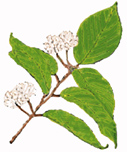DTP Branches and Offices
Success Story

Camptotheca acuminata, a member of the family Nyssaceae (tupelo family). Courtesy of Indiana University Biotech Department. From: Cyberbotanica. Description and natural history of Camptotheca.
Topotecan (NSC 609699)
Manufactured by GlaxoSmithKline as Hycamtin, topotecan garnered $203.5 million in sales in 2003. Hycamtin is approved by the FDA to treat ovarian cancers after failure of first-line chemotherapy, and it is the only drug approved by the FDA to treat small-cell lung cancers after failure of first-line chemotherapy.2
1958
Dr. Monroe E. Wall of the U.S. Department of Agriculture (at the time) and Dr. Jonathan Hartwell of NCI first discovered Camptotheca’s anticancer properties in 1958. After Dr. Wall joined the Research Triangle Institute in 1966, he and colleague Dr. Mansukh Wani, with support from NCI, isolated camptothecin, the active compound from the bark.
1970s
In the 1970s, Dr. Wall produced the sodium salt of camptothecin, which improved the solubility of the compound and allowed it to move into phase I clinical trials. The improvement was insufficient, however, and due to poor solubility and toxicity the drug did not progress to phase II trials. The compound remained of interest due to the discovery of its activity against the DNA replication enzyme topoisomerase I.
1980s
In the 1980s, NCI provided camptothecin to the University of Florida at Gainesville, where, with the support of SmithKline Beecham, an NCDDG headed by Dr. Warren Ross developed topotecan (NSC 609699),1 a semisynthetic, water-soluble analog of camptothecin. SmithKline Beecham further supported the formulation, toxicology studies, production, and phase I clinical trials of topotecan. The activity of this analog of camptothecin was confirmed as inhibition of topoisomerase I by Dr. Leroy Liu of Johns Hopkins University.
1990s
In the 1990s, NCI supported phase II clinical trials of topotecan, which gained FDA approval in 1996 for the treatment of ovarian and small-cell lung cancer. Topotecan is one of four NCDDG-developed agents approved by the FDA since the inception of the NCDDG program.
DTP’s RAID program also aided in the development of a liposomal formulation of a highly lipophilic camptothecin (DB67). In cell culture experiments, this agent was found to be twofold more cytotoxic than camptothecin, 25 times more lipophilic (thus more readily incorporated into liposomal bilayers), and more stable in human blood than any of the camptothecins in current clinical use. Support under RAID I included formulation, GMP synthesis, preliminary toxicology, and pharmacology studies. The principal investigator reapplied successfully under RAID IV for support of acquisition of additional bulk substance and IND-directed toxicology with correlative pharmacology and histopathology. RAID IV activities were closed out on licensure of the agent to Novartis.
1 Developmental Therapeutics Program. Grants and Contracts Operations Branch (GCOB) Website.
2 GlaxoSmithKline. Hycamtin Website.

Senior staff of the office field investigation of cancer, Public Health Service. Jonathan Hartwell, one of the first Westerners to recognize the anticancer properties of Camptotheca, is the third from the right. Courtesy of the National Cancer Institute. 1937.





